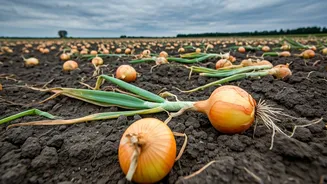Onion Price Plunge
The predicament faced by onion farmers in Maharashtra painted a grim picture of agricultural distress. The market was flooded, resulting in a dramatic
fall in onion prices. Farmers found themselves in a position where the cost of harvesting, transporting, and selling their produce exceeded the meager returns offered by the market. In a cruel twist, the value of the onions had sunk so low that it became financially unviable to sell them. The only option left for many was the heartbreaking act of destroying their harvest. This situation not only resulted in economic losses but also shattered the hopes and investments of countless farming families, highlighting the vulnerabilities within the agricultural sector.
Desperate Measures
Faced with the harsh realities of the market, farmers resorted to desperate measures in a bid to mitigate their losses. Many chose to discard their onions, ploughing them back into the soil or allowing them to rot. This painful choice underscored the severity of the economic crisis they were enduring. The financial burden was significant, as farmers had invested heavily in seeds, fertilizers, and labour, only to find themselves unable to recoup their costs. Some farmers were forced to leave their produce unsold in the fields, effectively abandoning their crop. Others attempted to sell their onions at exceptionally low prices, barely covering the cost of transportation. These actions highlighted the dire circumstances and the need for immediate intervention to prevent further devastation within the agricultural community. The scene became a symbol of the farmer's plight.
Economic Ripple Effect
The onion crisis went beyond the immediate losses suffered by farmers, creating a ripple effect that impacted the broader economy. The loss of income for farmers directly affected local markets, reducing spending and economic activity in rural areas. Reduced profitability weakened farmers' ability to invest in the next planting season, threatening future production. This, in turn, could lead to a cycle of scarcity and price volatility, harming both consumers and producers. The crisis also exposed the weaknesses in the agricultural supply chain, including inadequate storage facilities and inefficient market mechanisms. It underscored the importance of developing robust support systems and policies to safeguard farmers' livelihoods and ensure food security. The crisis exposed the need for the government's intervention to support farmers.
Government Response Needed
The onion crisis demanded a comprehensive and effective response from government authorities. While immediate actions might involve providing financial assistance or subsidies to farmers to offset their losses, it's essential to look at the root causes of the problem. This involved strengthening market infrastructure, improving storage facilities to prevent wastage, and exploring options for value addition and export promotion. Implementing crop insurance schemes and providing access to credit could also help to mitigate the risks faced by farmers. Long-term solutions involve the need for sustainable farming practices, ensuring fair pricing mechanisms, and empowering farmers through education and access to market information. A collaborative approach involving government, farmers, and market participants is vital to address the challenges faced by the farmers.















